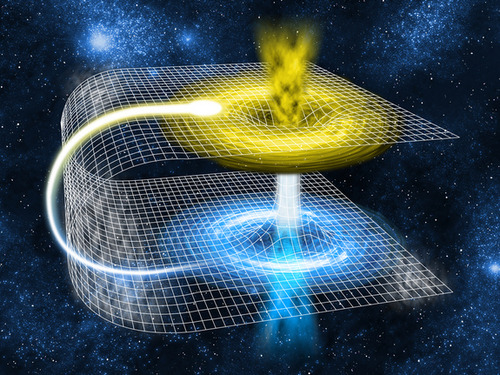Question:
I’ve read previously that scientists have figured out the geometry of the universe and it is flat. How then, can there be wormholes? If wormholes are two sections of spacetime connected, then wouldn’t the fabric of the universe have to be curved?
Asked by anonymous
Answer:
Wormholes are defined, broadly, as theoretical constructs allowed by general relativity that provide a shorter path between two distant regions of space or time by taking advantage of the curvature of spacetime. This definition, together with the theory that the observable universe is flat and that spacetime curves around bodies of macroscopic mass, like planets, stars, and other celestial bodies, automatically presents the idea that spacetime is akin to a uniform, two-dimensional sheet. Many representations of wormholes, like the one below, use this idea.
[Image: A model of ‘folded’ space-time illustrates how a wormhole bridge might form with at least two mouths that are connected to a single throat or tube. Credit: edobric| Shutterstock]
While this model works quite well for explaining the basic concept of a wormhole, it is a rather oversimplified model. An actual wormhole is much harder to imagine and depict because it operates in at least four dimensions – the three spatial dimensions, plus the time dimension. Trying to imagine a wormhole as it actually is introduces complexities that run counter to our common-sense three-dimensional perception, in the same manner that that diagram of the three-dimensional wormhole would give most of the two-dimensional inhabitants of Flatland a headache. Some of them might actually be asking this very same question about the sort of hole a worm might bore through an apple.
Wormholes do not actually operate as mere straight-line tunnels from one region of the universe to another, at least not in the conventional, three-dimensional sense that we can imagine. The entry and exit points of a wormholes would more likely be spheroidal regions of space that could only be identified topologically, because we are not equipped to observe constructs in higher dimensions— we can only theorize about their existence. Even if actual physical evidence of a wormhole were to be found, and even if that wormhole were to be traversable for long enough for you to successfully get through to the other side, you would not be able to see the actual structure of the wormhole – you’d only see a wildly distorted image of whatever’s at the other end.
Also, it must be stated that the observable universe is flat. While “universe” constitutes the set of everything that exists, the “observable universe” constitutes the part of the universe that we can directly observe; this is the volume of the universe around the Earth in which light has had time to reach us. That’s a sphere about 93 billion light-years across, taking into account the expansion of the universe, with the Earth at its center. We don’t have any way of knowing what lies beyond that horizon, because the light from that region hasn’t reached us yet, but regardless of the geometry of the entire universe, the part we can observe appears to be flat as far as we can measure it.
So while the observable universe is, on average, flat (at least to our knowledge), spacetime can curve quite significantly on a local scale, depending on the mass and the gravitational field of the object(s) in the vicinity. Wormholes take advantage of this curvature without affecting the average flatness of the observable universe on a macroscopic scale, so their existence is perfectly in keeping with these findings.
More information about wormholes can be found here:
http://www.space.com/20881-wormholes.html
http://physics.about.com/od/glossary/g/wormhole.htm
http://science.howstuffworks.com/science-vs-myth/everyday-myths/time-travel4.htm
For an idea of what it might look like to travel through a wormhole:
http://www.spacetimetravel.org/wurmlochflug/wurmlochflug.html
Answered by Shreniraj A., Expert Leader.
Edited by Yi Z.
Source:SciNote


